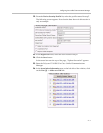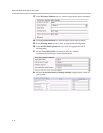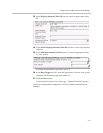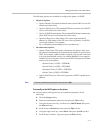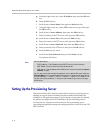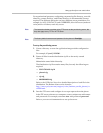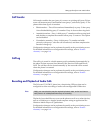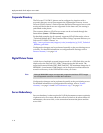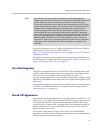
Deployment Guide for the Polycom VVX 1500 C
3 - 2
• If you choose to manage your phones through a provisioning server, you
need to:
— Set up a provisioning server and download the appropriate files. Refer
to Setting Up the Provisioning Server on page 3-4.
— Decide which features you want enabled and which you want
disabled. Refer to Configuring Your System on page 3-6.
— Create configuration files to support the required features on the
phones. Refer to Deploying Phones From the Provisioning Server on
page 3-10.
• If you do not want to use a provisioning server, you can change some of
the phone’s configuration through a web interface. Refer to Modifying
Phone’s Configuration Using the Web Interface on page B-1.
Because of the large number of optional installations and configurations that
are available, this chapter focuses on one particular way that the SIP
application and the required external systems might initially be installed and
configured in your network.
For more information on configuring the Polycom VVX 1500 C phone, refer to
the latest SIP Administrator’s Guide, which is available at
http://www.polycom.com/support/voice/business_media_phones/vvx150
0c.html .
Changing the Network Configuration
The Polycom VVX 1500 C phone requires several options to be set at boot time
in order to automatically pull its configuration files from an FTP server.
Alternatively, DHCP option 66 (or a DHCP option above 128) may be used to
instruct the phone where to get its configuration and application files. The
default username and password for the phone is PlcmSpIp. These defaults can
be changed in the boot menu of the phone. Any username/password change
on the phone should also be made on the FTP server.
All of the required options may be set by DHCP or manually on the phone
itself. With these options set, the phone will boot and automatically configure
itself to access the FTP server and upload the appropriate configuration files.
For installation and maintenance of the Polycom VVX 1500 C phone, the use of a
provisioning server is strongly recommended. This allows for flexibility in installing,
upgrading, maintaining, and configuring the phone. Configuration, log, and directory
files are normally located on this server. Allowing the phone write access to the
server is encouraged.
The phone is designed such that, if it cannot locate a provisioning server when it
boots up, it will operate with internally saved parameters. This is useful for
occasions when the provisioning server is not available, but is not intended to be
used for long-term operation of the phones.






